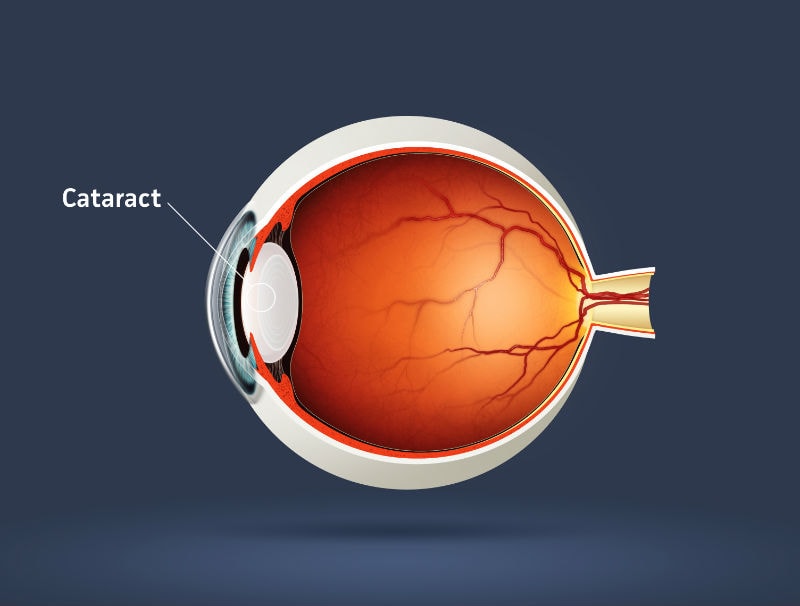A cataract is a cloudy area in the lens of your eye. Though painless, a cataract can cause blurred or hazy vision, and may make it more difficult to see well at night, read, watch television, or drive if left untreated. Let’s look at how a cataract forms and explore some of the most common causes of cataracts.
How a Cataract Forms
The lens is located behind the iris (the colored part of your eye) and functions much like the lens of a camera. It focuses light onto your retina, producing clear, sharp vision. The lens also controls your ability to focus and lets you see clearly close and at a distance.
Because of normal aging, the lens loses its flexibility and becomes thicker and less transparent. Over time, the tissues inside the lens break down and clump together, clouding a small area of the lens. This is a cataract, and as it continues to develop, it can grow larger and cloud a bigger portion of the lens. Since a cataract blocks and scatters light as it passes through the lens, your vision becomes blurred.
Causes of Cataracts
Now that you know how a cataract forms inside the lens, let’s look at some of the most common causes. During your eye exam at Rowan Eye Center, Dr. Rowan will discuss which of the following risk factors may increase your risk of developing a cataract.
- Age: Although a cataract can form at any age, your risk of developing them significantly increases as you get older. It’s been estimated that almost half of people in the United States ages 65 to 74 have a cataract, and nearly 70% of people over age 75 will develop them.
- Prolonged sun exposure: Excessive exposure to ultraviolet light from the sun increases your risk of cataract development. To protect your eyes, it’s best to wear sunglasses that block UVA and UVB rays whenever you’re outside, even on cloudy days.
- Smoking: Smokers are also at an increased risk. The toxic chemicals found in a cigarette can damage the cells in your body, including cells found in the lenses of your eyes. If you currently smoke, quitting smoking can reduce your risk of cataract development and help preserve your vision.
- Diabetes: Persistent high blood sugar levels caused from untreated diabetes can damage the lens of your eye over time, increasing your risk of developing a cataract.
- Nutritional deficiencies: Your diet may also play a role in the formation of a cataract. Some studies suggest that you may be at an increased risk of developing a cataract if your diet is low in antioxidants, such as vitamin C, vitamin A, vitamin E, and selenium. To keep your eyes healthy and your vision sharp, it’s important to eat a healthy diet consisting of brightly colored fruits and vegetables, lean proteins, whole grains, and good fats, such as monounsaturated fats and omega-3 fatty acids.
- Eye injury: An injury or any physical trauma to the eye can cause thickening and swelling of the lens, increasing your risk of developing a cataract.
- Eye diseases: Specific eye problems and diseases that cause inflammation and swelling affecting the inside of your eye, such as uveitis, can also increase your risk of cataract development.
- Alcohol: Though more research is needed, there is some evidence that suggests a relationship between cataract development and higher amounts of alcohol consumption.
- Prescription drugs: Long-term use of certain medications, such as corticosteroids and statins, are associated with an increased risk of cataract development.
- Family history: If your parents, siblings, or other family members have a cataract, you’re at an increased risk of developing them as well.
Cataract Diagnosis and Treatment at Rowan Eye Center
If your vision has become blurred or cloudy, or if you’re noticing an increased sensitivity to light and glare, contact Rowan Eye Center today to schedule an eye health examination. A comprehensive eye exam is the most effective way to detect and diagnose cataracts in their early stages. Don’t let a cataract interfere with your lifestyle or prevent you from engaging in activities you enjoy. Contact us today, and learn about the different cataract treatments available that can restore clear, sharp vision.

